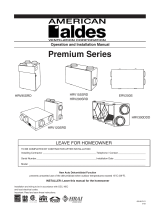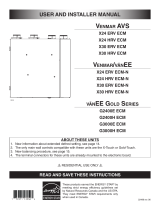Page is loading ...

ERVCRNVA
Owner’s Manual
Energy Recovery Ventilator
(ERV)
A13212
Fig. 1 − ERVCRNVA
SAFETY CONSIDERATIONS
Recognize safety information. This is the safety−alert symbol
When you see this symbol on the unit and in instructions or
manuals, be alert to the potential for personal injury. Understand
these signal words; DANGER, WARNING, and CAUTION. These
words are used with the safety−alert symbol. DANGER identifies
the most serious hazards which will result in severe personal injury
or death. WARNING signifies hazards which could result in
personal injury or death. CAUTION is used to identify unsafe
practices which would result in minor personal injury or product
and property damage. NOTE is used to highlight suggestions
which will result in enhanced installation, reliability, or operation.
ELECTRICAL OPERATION HAZARD
Failure to follow this warning could result in personal injury
or death.
Before servicing system, always turn off main power to
system. Turn off accessory heater power if applicable. There
may be more than one disconnect switch.
!
WARNING
PERSONAL INJURY HAZARD
Failure to follow this caution may result in personal injury.
Although special care has been taken to minimize sharp edges
in the construction of your unit, be extremely careful when
handling parts or reaching into the unit.
CAUTION
!
NOTE TO EQUIPMENT OWNER:
For your convenience, please record the model and serial numbers of your new equipment in the spaces
provided. This information, along with the installation data and dealer contact information will be helpful
should your system require maintenance or service.
ENERGY RECOVERY VENTILATOR
Model # ERVCRNVA1090
Serial # ______________________________________
ACCESSORIES (List type and model #)
_____________________________________________
_____________________________________________
_____________________________________________
_____________________________________________
INSTALLATION INFORMATION:
Date Installed ________________________________
DEALERSHIP CONTACT INFORMATION:
Company Name_______________________________
Address______________________________________
_____________________________________________
Phone Number _______________________________
Technician Name _____________________________
_____________________________________________
NOTE TO INSTALLER:
This manual must be left with the equipment owner.

2
UNIT OPERATION
Today’s houses are constructed using energy−saving building
practices and technologies. These practices and innovations help
reduce your utility bills, but prevent the introduction of fresh air.
Without ventilation, stale air and contaminants remain in the air for
extended periods of time. Stale, unhealthy air is generated from a
variety of sources including everyday living functions, cooking,
cleaning, painting, exhaust from attached garages, and off−gassing
of chemicals used in construction and furnishings. Your ERV
brings in fresh air and circulates it through your home around the
clock and expels stale air to help reduce the stuffy effects of
trapped indoor air.
The actual rate of ventilation is determined by the size of your
home, the number of bedrooms, and applicable local or national
ventilation codes. Your installing contractor has selected and set an
internal fan speed in the ERV to meet these fresh air requirements.
This unit is normally installed without a separate wall−mounted
control. It is generally wired directly to your furnace or fan coil
unit. The blower motor in the furnace or fan coil works in
conjunction with the two blowers in the ERV to circulate the air
through the ERV and duct system. There are no controls, settings,
or functions that need to be adjusted or changed by the
homeowner.
Continuous ventilation is provided when your thermostat is set
to the constant fan mode.
MAINTENANCE
1. The motors are factory lubricated. Lubricating the bearings
is not recommended.
2. A dirty air filter will cause excessive strain on the blower
motor. The filters in your ERV are washable and should be
cleaned every three months. Use a vacuum cleaner to
remove the heaviest portion of accumulated dust, then wash
in warm water.
NOTE: Do NOT clean these filters in a dishwasher or dry them
with heating appliances as they will be permanently damaged. Use
lukewarm water to clean filters, then air dry. Replace filters only
when they are completely dry.
3. The core should be vacuumed every three months to
remove dust that would inhibit the energy transfer. Do not
use water. The core should only be serviced when the
outdoor temperature is between 605F (165C) and 755F
(245C) and dry.
NOTE: If the edges of the core are soft, do not try to service the
core. The air passages can be damaged and/or closed off by
handling it or trying to remove it.
4. Regularly check the screen on the exterior intake hood and
clean as necessary.
INLET HOOD
EXHAUST HOOD
A13270
Fig. 2 − Inlet/Exhaust Ventilation
Heat Exchanger
Core
Filters
Front Door
(Remove for access
to core and lters.)
A13213
Fig. 3 − ERVCRNVA Components
BEFORE YOU REQUEST A SERVICE
CALL
S Check the main power disconnect switch. Verify that the circuit
breakers are ON or that fuses have not blown. If you must reset
breakers or replace fuses, do so only once. Contact your servicing
dealer for assistance if the breakers trip or the fuses blow a second
time.
S Check for sufficient airflow. Check air filters for accumulations of
large particles. Check for blocked exhaust−air grilles or ductwork.
Keep grilles and duct work open and unobstructed.
If your ERV still fails to operate properly, contact your servicing
dealer. Give the dealer your model and serial number. With this
information, the dealer will be able to correct any problems.
NOTE: During cold weather operation, it is possible for a small
amount of frost to accumulate on the heat exchange core inside the
ERV. If a large amount of frost or icing is present on the core,
ventilation performance will be reduced, and melting ice or frost
from the core may result in water damage. If you see a large
amount of ice or frost on the core, or water dripping from or
underneath the ERV, contact your installing contractor.
Copyright 2019 CAC / BDP S 7310 W. Morris St. S Indianapolis, IN 46231 Edition Date: 12/19
Manufacturer reserves the right to change, at any time, specifications and designs without notice and without obligations.
Catalog No: OM-ERVCRNVA-02
Replaces: OM-ERVCRNVA-01
ERV
/

